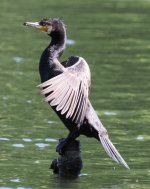Hi all, I'd like some suggestions on settings to stop shit like this from happening again.
This is a completely unedited crop of a cormorant drying its wings.
I'm using an OM System OM-1. 50-200mm F2.8-3.5 SWD with 2x teleconverter, 400mm@f7, 1/800, ISO probably 200 or 400. Hand-held, which may account for some blur. I also know that the 2x teleconverter does degrade sharpness -- I was trying it for the first time. I was using Aperture priority with bird detection + eye detection on.
The result is the wings are pretty well in focus but the eye is not sharp. I expected the eye to be in focus and damn the rest, based on he settings. But I got wing in focus for the most part, and head and eye are blurred. The bird was not really moving.
How can I get a better picture next time (I am going on a bird-watching excursion this weekend)? What's your recommendation for F-stop and ISO on a relatively bright afternoon?
This is a completely unedited crop of a cormorant drying its wings.
I'm using an OM System OM-1. 50-200mm F2.8-3.5 SWD with 2x teleconverter, 400mm@f7, 1/800, ISO probably 200 or 400. Hand-held, which may account for some blur. I also know that the 2x teleconverter does degrade sharpness -- I was trying it for the first time. I was using Aperture priority with bird detection + eye detection on.
The result is the wings are pretty well in focus but the eye is not sharp. I expected the eye to be in focus and damn the rest, based on he settings. But I got wing in focus for the most part, and head and eye are blurred. The bird was not really moving.
How can I get a better picture next time (I am going on a bird-watching excursion this weekend)? What's your recommendation for F-stop and ISO on a relatively bright afternoon?













